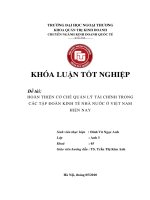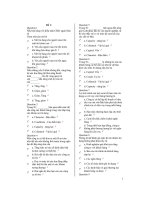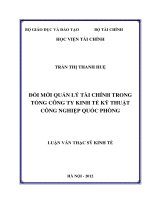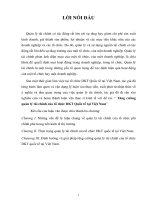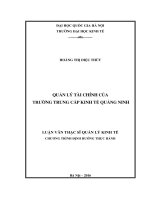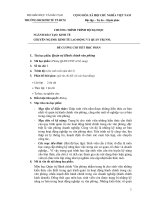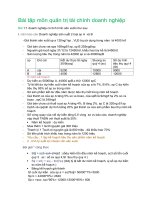ĐÁP ÁN SÁCH QUẢN TRỊ TÀI CHÍNH CUỐN TO DÀY uel KINH TE LUAT ĐÁP ÁN 10
Bạn đang xem bản rút gọn của tài liệu. Xem và tải ngay bản đầy đủ của tài liệu tại đây (67.11 KB, 11 trang )
Chapter 10
The Cost of Capital
Learning Objectives
After reading this chapter, students should be able to:
Explain what is meant by a firm’s weighted average cost of capital.
Define and calculate the component costs of debt and preferred stock. Explain why the
cost of debt is tax adjusted and the cost of preferred is not.
Explain why retained earnings are not free and use three approaches to estimate the
component cost of retained earnings.
Briefly explain the two alternative approaches that can be used to account for flotation
costs.
Briefly explain why the cost of new common equity is higher than the cost of retained
earnings, calculate the cost of new common equity, and calculate the retained earnings
breakpoint—which is the point where new common equity would have to be issued.
Calculate the firm’s composite, or weighted average, cost of capital.
Identify some of the factors that affect the WACC—dividing them into factors the firm
cannot control and those they can.
Briefly explain how firms should evaluate projects with different risks, and the problems
encountered when divisions within the same firm all use the firm’s composite WACC when
considering capital budgeting projects.
List some problems with cost of capital estimates.
Chapter 10: The Cost of Capital
Learning Objectives 243
Lecture Suggestions
Chapter 10 uses the rate of return concepts covered in previous chapters, along with the
concept of the weighted average cost of capital (WACC), to develop a corporate cost of capital
for use in capital budgeting.
We begin by describing the logic of the WACC, and why it should be used in capital budgeting.
We next explain how to estimate the cost of each component of capital, and how to put the
components together to determine the WACC. We go on to discuss factors that affect the
WACC and how to adjust the cost of capital for risk. We conclude the chapter with a
discussion on some problems with cost of capital estimates.
What we cover, and the way we cover it, can be seen by scanning the slides and
Integrated Case solution for Chapter 10, which appears at the end of this chapter solution. For
other suggestions about the lecture, please see the “Lecture Suggestions” in Chapter 2, where
we describe how we conduct our classes.
DAYS ON CHAPTER: 3 OF 58 DAYS (50-minute periods)
244 Lecture Suggestions
Chapter 10: The Cost of Capital
Answers to End-Of-Chapter Questions
10-1
Probable
Effect
on
rd(1 – T)
rs
WACC
a. The corporate tax rate is lowered.
+
0
+
b. The Federal Reserve tightens credit.
+
+
+
c. The firm uses more debt; that is, it increases
its debt/assets ratio.
+
+
0
d. The dividend payout ratio is increased.
0
0
0
e. The firm doubles the amount of capital it raises
during the year.
or +
f.
The firm expands into a risky new area.
0 or +
0 or +
0
+
+
+
g. The firm merges with another firm whose earnings
are counter-cyclical both to those of the first firm and
to the stock market.
–
–
–
h. The stock market falls drastically, and the firm’s stock
falls along with the rest.
0
+
+
i.
Investors become more risk averse.
+
+
+
j.
The firm is an electric utility with a large investment in
nuclear plants. Several states propose a ban on
nuclear power generation.
+
+
+
10-2
An increase in the risk-free rate will increase the cost of debt. Remember from Chapter
6, r = r RF + DRP + LP + MRP. Thus, if r RF increases so does r (the cost of debt).
Similarly, if the risk-free rate increases so does the cost of equity. From the CAPM
equation, rs = rRF + (r M – rRF)b. Consequently, if r RF increases rs will increase too.
10-3
Each firm has an optimal capital structure, defined as that mix of debt, preferred, and
common equity that causes its stock price to be maximized. A value-maximizing firm
will determine its optimal capital structure, use it as a target, and then raise new
capital in a manner designed to keep the actual capital structure on target over time.
The target proportions of debt, preferred stock, and common equity, along with the
costs of those components, are used to calculate the firm’s weighted average cost of
capital, WACC.
The weights could be based either on the accounting values shown on the firm’s
balance sheet (book values) or on the market values of the different securities.
Theoretically, the weights should be based on market values, but if a firm’s book value
weights are reasonably close to its market value weights, book value weights can be
Chapter 10: The Cost of Capital
Integrated Case 245
used as a proxy for market value weights. Consequently, target market value weights
should be used in the WACC equation.
10-4
In general, failing to adjust for differences in risk would lead the firm to accept too
many risky projects and reject too many safe ones. Over time, the firm would become
more risky, its WACC would increase, and its shareholder value would suffer.
The cost of capital for average-risk projects would be the firm’s cost of capital,
10%. A somewhat higher cost would be used for more risky projects, and a lower cost
would be used for less risky ones. For example, we might use 12% for more risky
projects and 9% for less risky projects. These choices are arbitrary.
10-5
The cost of retained earnings is lower than the cost of new common equity; therefore,
if new common stock had to be issued then the firm’s WACC would increase.
The calculated WACC does depend on the size of the capital budget. A firm
calculates its retained earnings breakpoint (and any other capital breakpoints for
additional debt and preferred). This R/E breakpoint represents the amount of capital
raised beyond which new common stock must be issued. Thus, a capital budget
smaller than this breakpoint would use the lower cost retained earnings and thus a
lower WACC. A capital budget greater than this breakpoint would use the higher cost
of new equity and thus a higher WACC.
Dividend policy has a significant impact on the WACC. The R/E breakpoint is
calculated as the addition to retained earnings divided by the equity fraction. The
higher the firm’s dividend payout, the smaller the addition to retained earnings and
the lower the R/E breakpoint. (That is, the firm’s WACC will increase at a smaller
capital budget.)
246 Integrated Case
Chapter 10: The Cost of Capital
Solutions to End-Of-Chapter Problems
10-1
rd(1 – T) = 0.12(0.65) = 7.80%.
10-2
Pp = $47.50; Dp = $3.80; rp = ?
rp =
10-3
Dp
Pp
=
$3.80
= 8%.
$47.50
40% Debt; 60% Common equity; rd = 9%; T = 40%; WACC = 9.96%; rs = ?
WACC = (wd)(r d)(1 – T) + (wc)(r s)
0.0996 = (0.4)(0.09)(1 – 0.4) + (0.6)r s
0.0996 = 0.0216 + 0.6rs
0.078 = 0.6rs
rs = 13%.
10-4
P0 = $30; D1 = $3.00; g = 5%; rs = ?
a. rs =
D1
$3.00
+g=
+ 0.05 = 15%.
P0
$30.00
b. F = 10%; re = ?
re =
D1
$3.00
+ g=
+ 0.05
P0 (1 F)
$30(1 0.10)
=
$3.00
+ 0.05 = 16.11%.
$27.00
10-5 Projects A, B, C, D, and E would be accepted since each project’s return is greater than
the firm’s WACC.
10-6
a. rs =
D1
$2.14
+g=
+ 7% = 9.3% + 7% = 16.3%.
P0
$23
b. rs = rRF + (r M – rRF)b
= 9% + (13% – 9%)1.6 = 9% + (4%)1.6 = 9% + 6.4% = 15.4%.
c. rs = Bond rate + Risk premium = 12% + 4% = 16%.
d. Since you have equal confidence in the inputs used for the three approaches, an
average of the three methodologies probably would be warranted.
Chapter 10: The Cost of Capital
Integrated Case 247
rs =
10-7
a. rs =
16.3% 15.4% 16%
= 15.9%.
3
D1
+g
P0
$3.18
+ 0.06
$36
= 14.83%.
=
b. F = ($36.00 – $32.40)/$36.00 = $3.60/$36.00 = 10%.
c. re = D1/[P0(1 – F)] + g = $3.18/$32.40 + 6% = 9.81% + 6% = 15.81%.
10-8
Debt = 40%, Common equity = 60%.
P0 = $22.50, D0 = $2.00, D1 = $2.00(1.07) = $2.14, g = 7%.
rs =
D1
$2.14
+g=
+ 7% = 16.51%.
P0
$22.50
WACC = (0.4)(0.12)(1 – 0.4) + (0.6)(0.1651)
= 0.0288 + 0.0991 = 12.79%.
10-9
Capital Sources
Long-term debt
Common Equity
Amount
$1,152
1,728
$2,880
Capital Structure Weight
40.0%
60.0
100.0%
WACC = wdrd(1 – T) + wcrs = 0.4(0.13)(0.6) + 0.6(0.16)
= 0.0312 + 0.0960 = 12.72%.
10-10 If the investment requires $5.9 million, that means that it requires $3.54 million (60%)
of common equity and $2.36 million (40%) of debt. In this scenario, the firm would
exhaust its $2 million of retained earnings and be forced to raise new stock at a cost of
15%. Needing $2.36 million in debt, the firm could get by raising debt at only 10%.
Therefore, its weighted average cost of capital is: WACC = 0.4(10%)(1 – 0.4) +
0.6(15%) = 11.4%.
10-11 rs = D1/P0 + g = $2(1.07)/$24.75 + 7%
= 8.65% + 7% = 15.65%.
WACC = wd(r d)(1 – T) + wc(r s); wc = 1 – wd.
13.95%
= wd(11%)(1 – 0.35) + (1 – wd)(15.65%)
0.1395 = 0.0715wd + 0.1565 – 0.1565w d
-0.017 = -0.085wd
wd = 0.20 = 20%.
248 Integrated Case
Chapter 10: The Cost of Capital
10-12 a. rd = 10%, rd(1 – T) = 10%(0.6) = 6%.
D/A = 45%; D0 = $2; g = 4%; P0 = $20; T = 40%.
Project A: Rate of return = 13%.
Project B: Rate of return = 10%.
rs = $2(1.04)/$20 + 4% = 14.40%.
b. WACC = 0.45(6%) + 0.55(14.40%) = 10.62%.
c. Since the firm’s WACC is 10.62% and each of the projects is equally risky and as
risky as the firm’s other assets, MEC should accept Project A. Its rate of return is
greater than the firm’s WACC. Project B should not be accepted, since its rate of
return is less than MEC’s WACC.
10-13 If the firm's dividend yield is 5% and its stock price is $46.75, the next expected
annual dividend can be calculated.
Dividend yield = D1/P0
5% = D1/$46.75
D1 = $2.3375.
Next, the firm's cost of new common stock can be determined from the DCF approach
for the cost of equity.
re = D1/[P0(1 – F)] + g
= $2.3375/[$46.75(1 – 0.05)] + 0.12
= 17.26%.
10-14 rp =
$100(0.11)
$11
=
= 11.94%.
$92.15
$92.15
10-15 a. Examining the DCF approach to the cost of retained earnings, the expected growth
rate can be determined from the cost of common equity, price, and expected
dividend. However, first, this problem requires that the formula for WACC be used
to determine the cost of common equity.
WACC = wd(r d)(1 – T) + wc(r s)
13.0%
= 0.4(10%)(1 – 0.4) + 0.6(r s)
10.6%
= 0.6rs
rs = 0.17667 or 17.67%.
From the cost of common equity, the expected growth rate can now be
determined.
rs = D1/P0 + g
0.17667 = $3/$35 + g
g = 0.090952 or 9.10%.
Chapter 10: The Cost of Capital
Integrated Case 249
b. From the formula for the long-run growth rate:
g = (1 – Div. payout ratio) ROE = (1 – Div. payout ratio) (NI/Equity)
0.090952 = (1 – Div. payout ratio) ($1,100 million/$6,000 million)
0.090952 = (1 – Div. payout ratio) 0.1833333
0.496104 = (1 – Div. payout ratio)
Div. payout ratio = 0.503896 or 50.39%.
10-16 a. With a financial calculator, input N = 5, PV = -4.42, PMT = 0, FV = 6.50, and then
solve for I/YR = g = 8.02% 8%.
b. D1 = D0(1 + g) = $2.60(1.08) = $2.81.
c. rs = D1/P0 + g = $2.81/$36.00 + 8% = 15.81%.
10-17 a.
rs =
D1
+g
P0
$3.60
+g
$60.00
0.09= 0.06 + g
g = 3%.
0.09=
b. Current EPS
Less: Dividends per share
Retained earnings per share
Rate of return
Increase in EPS
Plus: Current EPS
Next year’s EPS
$5.400
3.600
$1.800
0.090
$0.162
5.400
$5.562
Alternatively, EPS1 = EPS0(1 + g) = $5.40(1.03) = $5.562.
10-18 a. rd(1 – T) = 0.10(1 – 0.3) = 7%.
rp = $5/$49 = 10.2%.
rs = $3.50/$36 + 6% = 15.72%.
b. WACC:
Component
Debt [0.10(1 – T)]
Preferred stock
Common stock
Weight
0.15
0.10
0.75
After-tax
Cost
7.00%
10.20
15.72
Weighted
Cost
1.05%
1.02
11.79
WACC= 13.86%
=
c. Projects 1 and 2 will be accepted since their rates of return exceed the WACC.
250 Integrated Case
Chapter 10: The Cost of Capital
Chapter 10: The Cost of Capital
Integrated Case 251
10-19 a. If all project decisions are independent, the firm should accept all projects whose
returns exceed their risk-adjusted costs of capital. The appropriate costs of capital
are summarized below:
Project
A
B
C
D
E
F
G
H
Required
Investment
$4 million
5 million
3 million
2 million
6 million
5 million
6 million
3 million
Rate of
Return
14.0%
1.5
9.5
9.0
12.5
12.5
7.0
11.5
Cost of
Capital
12%
12
8
10
12
10
8
8
Therefore, Ziege should accept projects A, C, E, F, and H.
b. With only $13 million to invest in its capital budget, Ziege must choose the best
combination of Projects A, C, E, F, and H. Collectively, the projects would account
for an investment of $21 million, so naturally not all these projects may be
accepted. Looking at the excess return created by the projects (rate of return
minus the cost of capital), we see that the excess returns for Projects A, C, E, F, and
H are 2%, 1.5%, 0.5%, 2.5%, and 3.5%. The firm should accept the projects which
provide the greatest excess returns. By that rationale, the first project to be
eliminated from consideration is Project E. This brings the total investment
required down to $15 million, therefore one more project must be eliminated. The
next lowest excess return is Project C. Therefore, Ziege's optimal capital budget
consists of Projects A, F, and H, and it amounts to $12 million.
c. Since Projects A, F, and H are already accepted projects, we must adjust the costs
of capital for the other two value producing projects (C and E).
Project
C
E
Required
Investment
$3 million
6 million
Rate of
Return
9.5%
12.5
Cost of
Capital
8% + 1% = 9%
12% + 1% =13%
If new capital must be issued, Project E ceases to be an acceptable project. On the
other hand, Project C's expected rate of return still exceeds the risk-adjusted cost
of capital even after raising additional capital. Hence, Ziege's new capital budget
should consist of Projects A, C, F, and H and requires $15 million of capital, so $3
million of additional capital must be raised.
10-20 a. After-tax cost of new debt: rd(1 – T) = 0.09(1 – 0.4) = 5.4%.
Cost of common equity: Calculate g as follows:
With a financial calculator, input N = 9, PV = -3.90, PMT = 0, FV = 7.80, and then
solve for I/YR = g = 8.01% 8%.
rs =
D1
(0.55)($7.80)
$4.29
+g=
+ 0.08 =
+ 0.08 = 0.146 = 14.6%.
P0
$65.00
$65.00
252 Integrated Case
Chapter 10: The Cost of Capital
b. WACC calculation:
Component
Debt [0.09(1 – T)]
Common equity (RE)
Chapter 10: The Cost of Capital
Weight
0.40
0.60
After-tax
Cost
5.4%
14.6
Weighted
Cost
2.16%
8.76
WACC= 10.92%
=
Integrated Case 253
